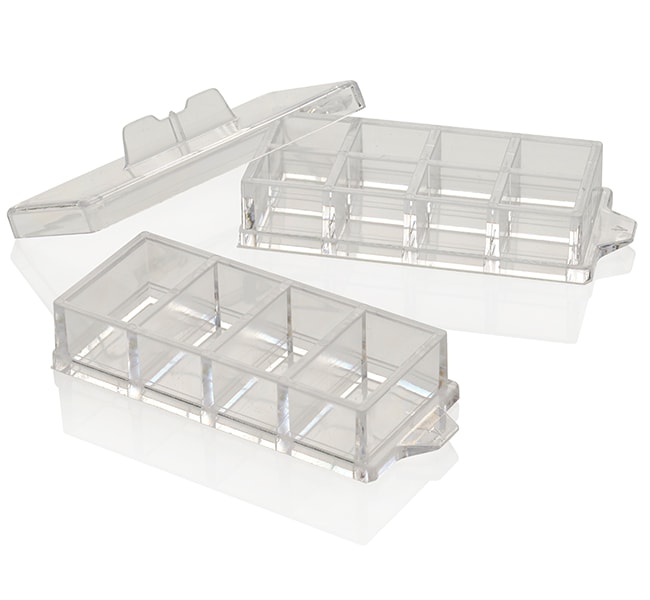Search Thermo Fisher Scientific

Cubreobjetos de vidrio con cámara Nunc™ Lab-Tek™ II
| Número de catálogo | Pocillos | Material | Descripción | Formato |
|---|---|---|---|---|
| 155382 | 4 | Vidrio de borosilicato, 1,5 | Cubreobjetos con cámara de 4 pocillos, con pocillos no extraíbles | Case of 96 |
| 155360 | 1 | Vidrio de borosilicato de 1.5 | Sistema de cubreobjetos de vidrio con cámara | Case of 96 |
| 155360PK también denominado 155360 | 1 | Vidrio de borosilicato de 1.5 | Sistema de cubreobjetos de vidrio con cámara | Pack of 16 |
| 155379 | 2 | Vidrio de borosilicato 1.5 | Cubreobjetos con cámara de 2 pocillos, con pocillos no extraíbles | Case of 96 |
| 155379PK también denominado 155379 | 2 | Vidrio de borosilicato 1.5 | Cubreobjetos con cámara de 2 pocillos, con pocillos no extraíbles | Pack of 16 |
| 155382PK | 4 | Vidrio de borosilicato, 1,5 | Cubreobjetos con cámara de 4 pocillos, con pocillos no extraíbles | Pack of 16 |
| 155409 | 8 | Vidrio borosilicatado 1.5 | Cubreobjetos con cámara de 8 pocillos, con pocillos no extraíbles | Case of 96 |
| 155409PK | 8 | Vidrio borosilicatado 1.5 | Cubreobjetos con cámara de 8 pocillos, con pocillos no extraíbles | Pack of 16 |
- Cámara de medios montada de forma segura en el cubreobjetos de borosilicato n.º 1.5 mediante adhesivo acrílico biocompatible
- La cámara de poliestireno no es extraíble y requiere un microscopio invertido para su visualización
- El intercambio de gases se consigue con una evaporación mínima a través de la cubierta de poliestireno con lengüetas
Información para pedidos:
- Se puede comprar en cajas de 96 o paquetes de 16.
- Se suministra estéril en prácticas bandejas de incubación apilables.
Garantía: 90 días
Kunden, die diesen Artikel ansahen, interessierten sich auch für
Documentos y descargas
Certificados
Product Information
Scientific Resources
Preguntas frecuentes
Please review the following possible causes and solutions:
- The microscope could be dirty from fingerprints or oils. We recommend cleaning your microscope prior to use and always after oil immersion. When using oil immersion, it is important to use the specific brand of oil designed and recommended for that particular microscope.
- An incorrect type of coverslip or coverglass can cause poor resolution. We recommend Nunc Lab-Tek Chambered Coverglass (made from 1.0 borosilicate glass) and Nunc Lab-Tek II Chambered Coverglass (made from 1.5 borosilicate glass) for the best resolution. Plastic coverslips may affect resolution at high magnification due to refractive index differences between the glass and plastic.
- An incorrect thickness for the coverglass can cause poor resolution. Please consult your microscope's manual for the best information.
- The coverslipping procedure may affect resolution. A clear seal is required, free of debris and particles. When performing oil immersion, bubbles may result in poor resolution under high magnification.
Lab-Tek and Lab-Tek II chambered coverglass products can be plated with cells, incubated, and handled in the same way. The two products differ in the thickness of the glass and the chamber size. Lab-Tek coverglass uses Borosilicate coverglass No. 1 that is 0.13 - 0.16 mm thick and Lab-Tek II coverglass uses Borosilicate coverglass No. 1.5 thath is 0.16 - 0.19 mm thick. Lab-Tek II coverglass chambers hold 10 - 50% more media than Lab-Tek coverglass chambers, depending on the format. Studies have shown that Lab-Tek II chambered coverglass works well with fastidious cells such as neuronal, as well as poorly adherent cell lines.
Lab-Tek products are compatible with all common fixatives, including paraformaldehyde. Acetone at 100% and some mixtures of acetone and alcohols are not compatible with the polystyrene upper well structure and will result in clouding or other effects of chemical attack. We encourage careful testing within planned operating conditions before working with high-value samples.
Lab-Tek chambered coverglasses are not accessories to Lab-Tek chamber slides, but another complete product for cell culture. The chambers are simply adhered to a borosilicate coverglass (to serve as the culture surface) rather than a soda lime glass or Permanox microscope slide. Most customers select this format for compatibility with confocal imaging systems that require a #1.0, approx. 120 micron (Lab-Tek) or #1.5, approx. 180 micron (Lab-Tek II) substrate. Because the coverglass is very thin and fragile, the chambered coverglasses (unlike chamber slides) cannot be disassembled.
Lab-Tek II chambered glass slide systems are available in our standard high-purity water washed culture treatment or our “CC2” surface modification. The latter is a proprietary passive treatment that resembles poly-D-lysine, often improving culture performance when working with fastidious cells such as neuronal cultures.